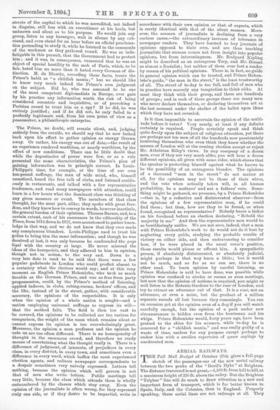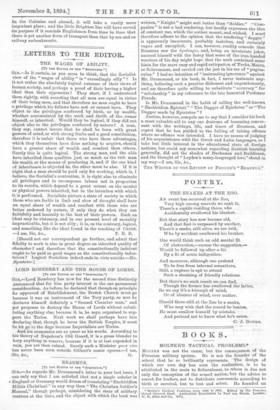AERIAL RAILWAYS.
THE Pall Mall Budget of October 27th gives a full-page sketch of the passenger-car of the new aerial railway between the two peaks of the "Devil's Dyke" at Brighton. The distance traversed is not great,-1,100 ft. from bill to hill, at a maximum height of 230 ft. above the valley. But the Brighton "Telpher" line will do much to draw attention to a new and important form of transport, which is far better known in Spain, Italy, and the Colonies, than in England. Properly speaking, these aerial lines are not railways at all. They
are not even rope-railways, such as those which had been long in use in quarries, before the steam-engine had de- veloped into a locomotive, and was employed to haul trucks along lines of rails by winding a rope. The new " Telpher " system inverts the principle of the railroad, as, instead of resting upon rails, the cars are slung to an overhead rope, along which they travel, suspended from grooved wheels, re- volving between fixed supports. The invention is a good example of the consequences which follow on the discovery of a new material for old uses. The single rope-bridges of the Himalayas and the Thibetan frontier, are probably one of the oldest and simplest engineering devices known. A rough rope, sometimes made only of twisted birch-twigs, is fastened across the chasm of a mountain torrent, and round this is hung a hoop. In this the passenger sits, and hauls himself across by hitching the hoop forwards as he holds the rope above with his hands. The only development of this primitive system was the addition of a second rope, an endless cord, by which the passenger in the hoop was drawn across from either side, with no more risk than was involved in the task of keeping himself from falling out of the hoop in which he sat. Some such rough form of transport, with buckets and wheels substituted for the hoop, was used for many years in the lead mines of the Peak of Derbyshire ; but if hemp had remained the strongest material for rope.making, the aerial railway would never have taken the place which it has, or attracted the attention which it now claims, among the practical means of cheap transport. The invention of the twisted steel rope has made the development of the aerial railway practically safe and commercially possible, and more than two thousand miles of line are now in working order in Spain, Italy, South America, India, the Cape, China, and Japan. To " ovea-seas Englishmen," the cable-way at Hong- kong is as well-known as the "Devil's Dyke" line will soon be to London visitors to Brighton. It shares with the latter the distinction of being the only aerial line used solely for passenger-traffic, though it was built for useful and commercial reasons. It was found necessary to transport all European workmen in the port up the mountain every night, in order to sleep in purer air, and the cheapest and quickest means was found to be the construction of a "Telpher" line. The saving in time alone is said to have already repaid the cost of its construction. Nothing could be simpler than this Hong-kong line. It is carried straight up the mountain-side, the endless line stretching from ravine to ravine, on high steel trestles, through which the little back-to-back cars run on the rope like a section of the "knife-board" of an old-fashioned omnibus. Three passengers sit on each side ; and though the height at which they travel must be trying to the nerves, they are not shut in by aprons of steel wire, as in the case of the Brighton cars. An awning, for protection from the sun, is the sole addition to the minimum of accommodation provided on this airy journey. The length of the line is two miles, and the exact height ascended 1,090 ft. The Chinese population of Hong-kong were much disturbed by the invasion of the mountain by this railway. They attributed the epidemic of the plague to the anger of the mountain demons, who were prevented by the wires from making their nightly flights round the circuit of the hill. The difficulties in the con- struction of the Table Mountain wire-line were far greater than in that at Hong-kong. A precipice and incline of 800 ft. in height interrupted the ascent midway. The summit of this precipice was used as a support, and the suspending wire leapt in a single span of 1,470 ft. to the edge of the cliff, and from thence in another span of 1,400 ft. to the flat top of the mountain. The loads carried across these gulfs average half a ton each, and the line is used both for passenger and goods traffic. The Rock of Gibraltar has also its wire line, though of slighter build, and far more striking steepness. The height to the signal station is barely a quarter less than the total length of the line, and the wire runs straight to the summit on a series of lofty trestles, after a first hap of 1,100 ft., in an ascent of ift. in every 1 ft, Viewed against the sky, looking parallel to the mountain side, it looks like a telegraph-wire stretched tight from the tops of a series of little Eiffel towers ; yet the Eoldiers ascend and descend in the little wooden boxes which travel on it, with equal safety and comfort. The Hong-kong, Gibra'tar, and Table Mountain lines are worked on a double cable, along which one car ascends es the other descends, the two being connected by a hauling rope.
But these are toys, compared with the complicated and ever- increasing system of aerial trains now working in the great iron mines of Spain. Near Bilbao, the greater part of a mountain side is quarried away at different levels to obtain the fine iron ore, which is carried to the railway by nine lines,. running from the station at the foot of the mountain to the mines along the summit. These nine lines carry on an average 2,300 tons of ore a day, none of which touches the level of the ground till it has travelled some five miles through space. The appearance of these multiplex lines of wire, stretching from tower to tower of light trellised iron, and hung at intervals. with hundreds of ore-carriages in constant motion, is one of the strangest spectacles in modern mining enterprise. The double line of iron scaffolds, where it leaves the terminus in the valley, looks like the support for some enormous viaduct,. festooned with wires slung with rows of pendent buckets. Higher up the mountain, where deep ravines cut the face of the bill, the trestles tower to such a height, that the travelling loads of ore look like little black balls against the sky. When the different levels of the mine are reached, the lines of the wire-way diverge, and are carried to nine separate points in the workings. Yet the traffic is controlled with little difficulty, and there is no risk of any serious stoppage by accident, as in the case of a breakdown on the trunk lines of a great railway. At the worst, one or two lines only would be blocked, leaving the others free for use. It is calculated that one hundred thousand tons of ore can be carried on each of these cables before it becomes unfit for service. In crossing wide ravines or rivers, where one bank is lower than another, the aerial line is used exactly as the old-fashioned funicular railway works, the descending load being used to haul up the
car. In the Alps, the Pyrenees, and in the bridging of deep river-beds, this is the simplest and cheapest form of transport known. In the Italian Alps, a span of 1,500 yard9 is crossed without a support, and this " gossamer " transport is soon to be applied to distances of 2,000 yards. The usual means of drawing the load on level lines where it is not carried by the force of gravity, is to revolve the endless cord. by a drum worked by steam. But a recent and ingenious. invention promises a further development of aerial lines. The steel rope is charged with an electric current, and the ears themselves carry a motor which "picks up" its power as it travels along the wire.
It is to be hoped that in the coming discussion on the sub- ject of light railways, promoted by the President of the Board of Trade, the future possibilities of these aerial tram- ways may not be forgotten. English manufacturers of the machinery should see that they are represented. The system, is so little known in England, that there is some danger of its being omitted from the discussion, and so being hampered in its future development by the restrictive rules and regu].a- tions, dating from the early days of railway enterprise, which, have checked the growth of light railways, and discouraged every form of steam-carriage except that on the heavy lines. It would be matter for regret if a means of transport so cheap and so simple were checked for years. by some unmeaning prohibition, as the electric-tram ha& been checked by the Board of Trade rule which re- fuses to allow wires carried above the surface. The limits. of usefulness of the aerial railway have not yet been reached. Probably great weights will never be carried on the lines in single cars. But the transport of smaller quantities. on the endless ropes can be multiplied almost without limit by increasing the number of parallel lines. It is not only the- cheapest, but often the only possible form of transport in places inaccessible to ordinary railways ; and the absence of danger from collision more than compensates for the first trial to the nerves made in the aerial transit. For ordinary ferry-work across rivers, the system is probably too like a makeshift to satisfy the English mind, But it is as an auxiliary transport, cheap and convenient, that it deserves a place among the everyday expedients of modern life. In commercial cities it would supply a means of parcel-transport by the shortest route, from point to point, above the houses, with little greater disturbance than that caused by erecting telephone wires ; and in its simplest form it would be a useful auxiliary on every large farm in which manure and food has to be transported up.hill, sand or seaweed carried up from the shore, or water drawn and taken to a distance. These are some of the obvious uses for the aerial railway in this country.
In the Colonies and abroad, it will take a vastly more important place ; and the little Brighton line will have served its purpose if it reminds Englishmen from time to time that there is yet another form of transport than that by sea and on railway embankments.




















































 Previous page
Previous page